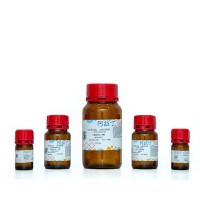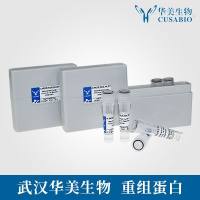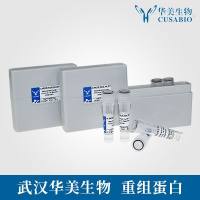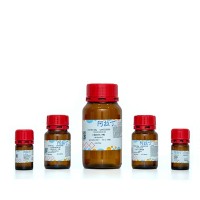UV Crosslinking of Proteins to Nucleic Acids
互联网
- Abstract
- Table of Contents
- Materials
- Figures
- Literature Cited
Abstract
Irradiation of protein?nucleic acid complexes with ultraviolet light causes covalent bonds to form between the nucleic acid and proteins that are in close contact with the nucleic acid. Thus, UV crosslinking may be used to selectively label DNA?binding proteins based on their specific interaction with a DNA recognition site. As a consequence of label transfer, the molecular weight of a DNA?binding protein in a crude mixture can be rapidly and reliably determined. This unit provides 3 protocols for executing DNA?protein crosslinking; one uses the halogenated thymidine analog bromodeoxyuridine (BrdU) to produce a DNA probe that is especially sensitive to UV?induced crosslinking. An alternate protocol describes crosslinking using a non?BrdU substituted probe, and another alternate protocol provides a method for in situ crosslinking.
Table of Contents
- Basic Protocol 1: UV Crosslinking Using a Bromodeoxyuridine‐ Substituted Probe
- Alternate Protocol 1: UV Crosslinking Using a Non–Bromodeoxyuridine‐Substituted Probe
- Alternate Protocol 2: UV Crosslinking In Situ
- Reagents and Solutions
- Commentary
- Figures
Materials
Basic Protocol 1: UV Crosslinking Using a Bromodeoxyuridine‐ Substituted Probe
Materials
Alternate Protocol 1: UV Crosslinking Using a Non–Bromodeoxyuridine‐Substituted Probe
Additional Materials
Alternate Protocol 2: UV Crosslinking In Situ
Additional Materials
|
Figures
-
Figure 12.5.1 Experimental setup for UV crosslinking DNA‐binding proteins to uniformly labeled DNA. View Image -
Figure 12.5.2 Representation of autoradiogram of a typical UV crosslinking experiment. As described in commentary, procedure involves UV crosslinking of protein to DNA probe, digestion of free DNA with DNase, and electrophoresis by SDS‐PAGE of the treated binding reactions. Molecular weights of 14 C‐labeled protein markers in Lane 1 are indicated to the left. Lanes 2 through 10 each contained a 14 C‐labeled DNA probe with a site for a binding protein X. Samples applied to the lanes differed as follows (see also anticipated results): Lane 2 —no protein; Lane 3— no UV irradiation; Lane 4 —5 min irradiation of complete binding reaction; Lane 5 —15 min irradiation of complete binding reaction; Lane 6 —30 min irradiation of complete binding reaction; Lane 7 —60 min irradiation of complete binding reaction; Lane 8 —60 min irradiation of complete binding reaction then proteinase K treatment; Lane 9 —60 min irradiation of complete binding reaction plus 100‐fold molar excess of unlabeled probe containing a binding site for protein X; Lane 10 —60 min irradiation of complete binding reaction plus 100‐fold molar excess of unlabeled mutant probe lacking a binding site for protein X. View Image
Videos
Literature Cited
| Literature Cited | |
| Chodosh, L.A., Carthew, R.W., and Sharp, P.A. 1986. A single polypeptide possesses the binding and transcription activities of the adenovirus major late transcription factor. Mol. Cell. Biol. 6:4723‐4733. | |
| Hillel, Z. and Wu, C.‐W. 1978. Photochemical cross‐linking studies on the interaction of Escherichia coli RNA polymerase with T7 DNA. Biochemistry 17:2954‐2961. | |
| Lin, S.‐Y. and Riggs, A.D. 1974. Photochemical attachment of lac repressor to bromodeoxyuridine‐substituted lac operator by ultraviolet radiation. Proc. Natl. Acad. Sci. U.S.A. 71:947‐951. | |
| Markowitz, A. 1972. Ultraviolet light–induced stable complexes of DNA and DNA polymerase. Biochim. Biophys. Acta 281:522‐534. | |
| Simpson, R.B. 1979. The molecular topography of RNA polymerase–promoter interaction. Cell 18:277‐285. | |
| Wu, C., Wilson, S., Walker, B., Dawid, I., Paisley, T., Zimarino, V., and Ueda, H. 1987. Purification and properties of Drosophila heat shock activator protein. Science 238:1247‐1253. | |
| Key References | |
| Chodosh et al., 1986. See above. | |
| Describes UV crosslinking in crude mammalian extracts and demonstrates specificity of binding of the crosslinked proteins. Compares the technique with other methods for determining the molecular weight of DNA‐binding proteins. | |
| Hillel and Wu, 1978. See above. | |
| An excellent study of the differences in polymerase‐DNA contacts in specific and nonspecific complexes. | |
| Lin and Riggs, 1974. See above. | |
| A seminal paper describing the use of BrdU in photochemical crosslinking. |







